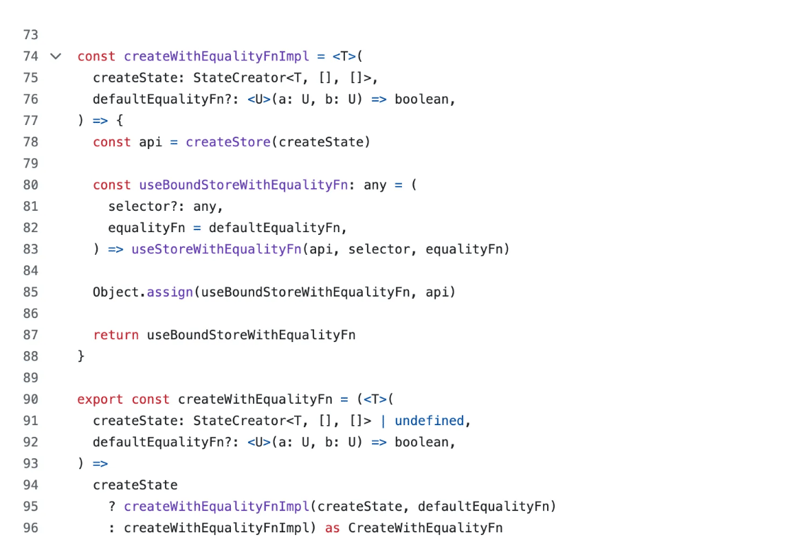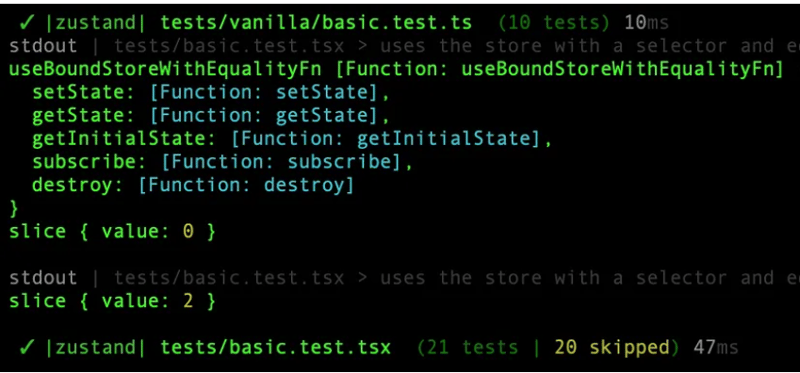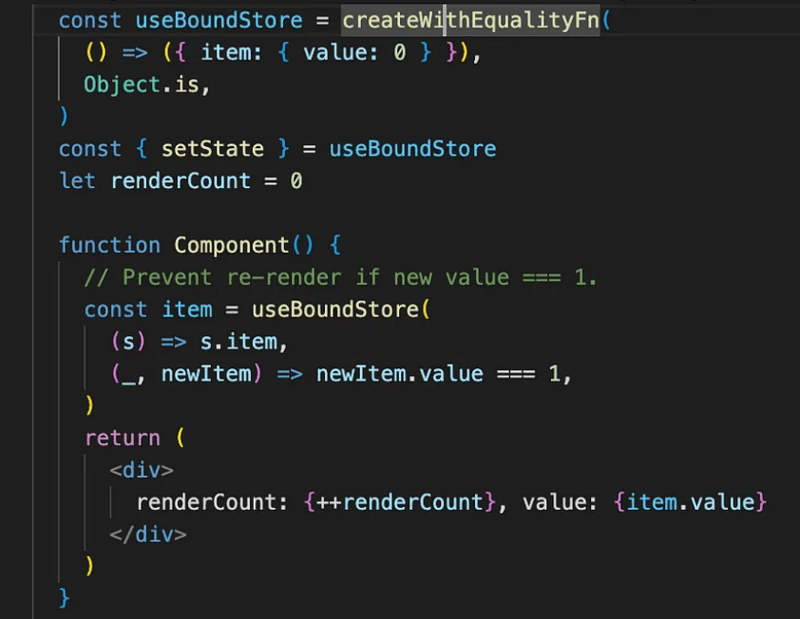createWithEqualityFnImpl in Zustand’s source code explained.
In this article, we will analyse how the createWithEqualityFnImpl is implemented by logging some of its value to get a better understanding.

As you can tell from the above image, createWithEqualityFn calls the function createWithEqualityFnImpl. This pattern is used in vanilla.ts as well as demonstrated below:
export const createStore = ((createState) => createState ? createStoreImpl(createState) : createStoreImpl) as CreateStore
createStore calls createStoreImpl and createWithEqualityFn calls createWithhEqualityFnImpl.
Before we jump into the execution of createWithEqualityFn, let’s first understand the purpose of using createWithEqualityFn.

The above screenshot is from https://github.com/pmndrs/zustand/tree/main
You can use createWithEqualityFn to have more control over re-rendering.
createWithEqualityFn
const createWithEqualityFnImpl =( createState: StateCreator , defaultEqualityFn?: (a: U, b: U) => boolean, ) => { const api = createStore(createState) const useBoundStoreWithEqualityFn: any = ( selector?: any, equalityFn = defaultEqualityFn, ) => useStoreWithEqualityFn(api, selector, equalityFn) Object.assign(useBoundStoreWithEqualityFn, api) return useBoundStoreWithEqualityFn }
useStoreWithEqualityFn
export function useStoreWithEqualityFn>( api: S, ): ExtractStateexport function useStoreWithEqualityFn, U>( api: S, selector: (state: ExtractState) => U, equalityFn?: (a: U, b: U) => boolean, ): U export function useStoreWithEqualityFn( api: ReadonlyStoreApi , selector: (state: TState) => StateSlice = identity as any, equalityFn?: (a: StateSlice, b: StateSlice) => boolean, ) { const slice = useSyncExternalStoreWithSelector( api.subscribe, api.getState, api.getInitialState, selector, equalityFn, ) useDebugValue(slice) return slice }
This is an overloading function. useStoreWithEqualityFn has 3 definitions:
export function useStoreWithEqualityFn>( api: S, ): ExtractStateexport function useStoreWithEqualityFn, U>( api: S, selector: (state: ExtractState) => U, equalityFn?: (a: U, b: U) => boolean, ): U export function useStoreWithEqualityFn( api: ReadonlyStoreApi , selector: (state: TState) => StateSlice = identity as any, equalityFn?: (a: StateSlice, b: StateSlice) => boolean, ) {

Let’s see how the slice value looks like:

value: 1 is skipped because we set the code to avoid re-render when the value is 1 as shown below:

About us:
At Think Throo, we are on a mission to teach the best practices inspired by open-source projects.
10x your coding skills by practising advanced architectural concepts in Next.js/React, learn the best practices and build production-grade projects.
We are open source — https://github.com/thinkthroo/thinkthroo (Do give us a star!)
Up skill your team with our advanced courses based on codebase architecture. Reach out to us at [email protected] to learn more!
References:
https://github.com/pmndrs/zustand/blob/main/src/traditional.ts#L74
https://github.com/pmndrs/zustand/blob/main/src/traditional.ts#L39
-
 Send data between tabs in React.In this article will look at how to send data between components in React globally, even in different browser tabs. Story Imagine you have a l...Programming Published on 2024-11-08
Send data between tabs in React.In this article will look at how to send data between components in React globally, even in different browser tabs. Story Imagine you have a l...Programming Published on 2024-11-08 -
 How to Optimize JSON Response Performance in FastAPI for Large Data?Improving Performance for JSON Response in FastAPI with Large DataFastAPI users encounter significant delays when returning voluminous JSON data via e...Programming Published on 2024-11-08
How to Optimize JSON Response Performance in FastAPI for Large Data?Improving Performance for JSON Response in FastAPI with Large DataFastAPI users encounter significant delays when returning voluminous JSON data via e...Programming Published on 2024-11-08 -
 How to Modify an ObservableCollection From a Non-Dispatcher Thread in WPF?"This Type of CollectionView Does Not Support Changes to Its SourceCollection from a Thread Different from the Dispatcher Thread"Problem Des...Programming Published on 2024-11-08
How to Modify an ObservableCollection From a Non-Dispatcher Thread in WPF?"This Type of CollectionView Does Not Support Changes to Its SourceCollection from a Thread Different from the Dispatcher Thread"Problem Des...Programming Published on 2024-11-08 -
 What\'s the difference between Datetime and Timestamp in SQL Server?Understanding the Distinction between Datetime and Timestamp in SQL ServerWhile both Datetime and Timestamp data types in SQL Server handle dates and ...Programming Published on 2024-11-08
What\'s the difference between Datetime and Timestamp in SQL Server?Understanding the Distinction between Datetime and Timestamp in SQL ServerWhile both Datetime and Timestamp data types in SQL Server handle dates and ...Programming Published on 2024-11-08 -
 How to Build Stunning Websites with Modern Front-End Development TechniquesIn today’s digital era, web design plays a crucial role in making a lasting impression on visitors. With millions of websites competing for attention,...Programming Published on 2024-11-08
How to Build Stunning Websites with Modern Front-End Development TechniquesIn today’s digital era, web design plays a crucial role in making a lasting impression on visitors. With millions of websites competing for attention,...Programming Published on 2024-11-08 -
 Let&#s create a simple React hook to detect browsers and their capabilitiesUser agent sniffing is the most popular approach for browser detection. Unfortunately, it's not very accessible for a front end development becaus...Programming Published on 2024-11-08
Let&#s create a simple React hook to detect browsers and their capabilitiesUser agent sniffing is the most popular approach for browser detection. Unfortunately, it's not very accessible for a front end development becaus...Programming Published on 2024-11-08 -
 E-Commerce Platform with Golang : Understanding clean architectureUnderstanding Clean Architecture Clean Architecture, popularized by Robert C. Martin, is a software design philosophy that separates the elem...Programming Published on 2024-11-08
E-Commerce Platform with Golang : Understanding clean architectureUnderstanding Clean Architecture Clean Architecture, popularized by Robert C. Martin, is a software design philosophy that separates the elem...Programming Published on 2024-11-08 -
 TypeScript vs JavaScript: Key Differences for DevelopersJavaScript is the core language of the web, while TypeScript is a modern enhancement that builds on it. Both are powerful, but they serve slightly dif...Programming Published on 2024-11-08
TypeScript vs JavaScript: Key Differences for DevelopersJavaScript is the core language of the web, while TypeScript is a modern enhancement that builds on it. Both are powerful, but they serve slightly dif...Programming Published on 2024-11-08 -
 ey questions that every PHP expert should answerSince the mid-1990s, PHP has been a crucial language for web development, widely used in website backends. Despite the emergence of new languages and...Programming Published on 2024-11-08
ey questions that every PHP expert should answerSince the mid-1990s, PHP has been a crucial language for web development, widely used in website backends. Despite the emergence of new languages and...Programming Published on 2024-11-08 -
 Can JavaScript Implement Dynamic Getters and Setters for Unpredictable Properties?Can JavaScript Implement Dynamic Getters/Setters?Dynamic getters and setters allow JavaScript objects to handle property access and modification beyon...Programming Published on 2024-11-08
Can JavaScript Implement Dynamic Getters and Setters for Unpredictable Properties?Can JavaScript Implement Dynamic Getters/Setters?Dynamic getters and setters allow JavaScript objects to handle property access and modification beyon...Programming Published on 2024-11-08 -
 My first open-source project built with Python to inspect databases through CLI fastWhat my problem was: While working on other projects, I found myself always having to connect and use SELECT * to see dummy entries or new users. I fa...Programming Published on 2024-11-08
My first open-source project built with Python to inspect databases through CLI fastWhat my problem was: While working on other projects, I found myself always having to connect and use SELECT * to see dummy entries or new users. I fa...Programming Published on 2024-11-08 -
 PHP, The elephant that doesn't fall!Photo by Ben Griffiths on Unsplash PHP is a language widely applauded and at the same time criticized by others, some say it is dying but is it really...Programming Published on 2024-11-08
PHP, The elephant that doesn't fall!Photo by Ben Griffiths on Unsplash PHP is a language widely applauded and at the same time criticized by others, some say it is dying but is it really...Programming Published on 2024-11-08 -
 How to Securely Access Remote MySQL Databases from Android Applications?Accessing Remote MySQL Databases in Android with JDBC: A Comprehensive AnalysisConnecting to MySQL databases remotely from Android applications using ...Programming Published on 2024-11-08
How to Securely Access Remote MySQL Databases from Android Applications?Accessing Remote MySQL Databases in Android with JDBC: A Comprehensive AnalysisConnecting to MySQL databases remotely from Android applications using ...Programming Published on 2024-11-08 -
 Creating custom mouse cursors with CSSWritten by Samson Omojola✏️ Editor’s note: This article was last updated by Njong Emy on 5 August 2024 to update content and code blocks, as well as t...Programming Published on 2024-11-08
Creating custom mouse cursors with CSSWritten by Samson Omojola✏️ Editor’s note: This article was last updated by Njong Emy on 5 August 2024 to update content and code blocks, as well as t...Programming Published on 2024-11-08 -
 How to Fix \"Extension Context Invalidated\" Errors Caused by Orphaned Content Scripts in Chrome Extensions?How to Remove Orphaned Script after Chrome Extension UpdateProblemUnintentionally reloading a Chrome extension, particularly those in developer mode, ...Programming Published on 2024-11-08
How to Fix \"Extension Context Invalidated\" Errors Caused by Orphaned Content Scripts in Chrome Extensions?How to Remove Orphaned Script after Chrome Extension UpdateProblemUnintentionally reloading a Chrome extension, particularly those in developer mode, ...Programming Published on 2024-11-08
Study Chinese
- 1 How do you say "walk" in Chinese? 走路 Chinese pronunciation, 走路 Chinese learning
- 2 How do you say "take a plane" in Chinese? 坐飞机 Chinese pronunciation, 坐飞机 Chinese learning
- 3 How do you say "take a train" in Chinese? 坐火车 Chinese pronunciation, 坐火车 Chinese learning
- 4 How do you say "take a bus" in Chinese? 坐车 Chinese pronunciation, 坐车 Chinese learning
- 5 How to say drive in Chinese? 开车 Chinese pronunciation, 开车 Chinese learning
- 6 How do you say swimming in Chinese? 游泳 Chinese pronunciation, 游泳 Chinese learning
- 7 How do you say ride a bicycle in Chinese? 骑自行车 Chinese pronunciation, 骑自行车 Chinese learning
- 8 How do you say hello in Chinese? 你好Chinese pronunciation, 你好Chinese learning
- 9 How do you say thank you in Chinese? 谢谢Chinese pronunciation, 谢谢Chinese learning
- 10 How to say goodbye in Chinese? 再见Chinese pronunciation, 再见Chinese learning

























